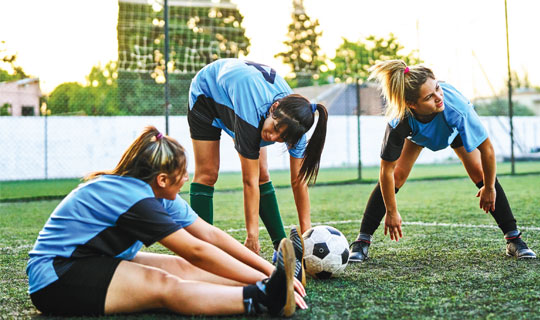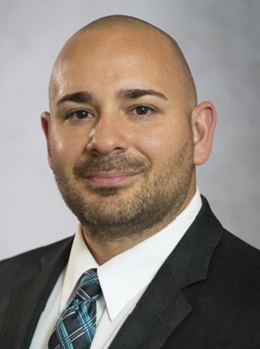
Reducing injuries in young athletes can improve performance and boost success both on and off the field.
Youth sports are an excellent way for children and adolescents to stay active, learn skills and make friends. But with any physical activity comes the risk of injuries that can sometimes have a long-term impact.

“Sports injuries are not confined to the field; they can have lasting effects on an athlete’s quality of life,” says Jason Krystofiak, MD, Section Chief of Sports Medicine at Cooperman Barnabas Medical Center (CBMC); Medical Director of Sports Medicine for RWJBarnabas Health; and a member of RWJBarnabas Health Medical Group. “Early intervention and comprehensive treatment are essential.”
Sports medicine often focuses on treating prevalent injuries such as ligament sprains and muscle strains. But it’s also important to improve safety in youth sports and prevent common injuries from occurring in the first place, says Dr. Krystofiak.
Doing so takes another kind of team effort: parents, coaches and health care providers working together to holistically promote safety and safeguard youth health and well-being.
Collaboratively fostering good habits not only reduces the risk of injuries but also optimizes performance and helps ensure that young athletes enjoy sports and have lasting success.
The following key steps can help protect youth from injuries.
1. Build Awareness

“Injury prevention starts with education,” says Peter DeLuca, MD, Chief of Orthopedic Sports Medicine at CBMC and a member of RWJBarnabas Health Medical Group, who has treated high school, college and professional athletes including hockey players with the New Jersey Devils and women soccer players with Gotham FC. “Athletes need to be aware of their limitations and listen to the signals their bodies send.”
Coaches, parents, athletes and health care professionals need to communicate transparently about data linked to overuse injuries and ask questions if anything is unclear, Dr. DeLuca says. Parents play an especially pivotal role in promoting the well-being of young athletes, Dr. Krystofiak emphasizes.
Instilling good daily practices such as getting enough sleep and eating a balanced diet helps optimize performance and reduces injury risks, especially for student-athletes who must balance sports commitments with academic responsibilities.
2. Prepare the Body
Some sports injuries are unavoidable. Others can be prevented through proper preparation and conditioning. Stretching before physical activity can help prevent strains and sprains, says Dr. DeLuca, who cites research indicating that stretching can reduce the risk of injury. “I always advise athletes to focus on flexibility and strength training both in the off-season and during the season,” he says.
For example, exercise routines can help lessen the likelihood of non-contact ACL (anterior cruciate ligament) tears, which are notably rising among female athletes, Dr. DeLuca says. “A proper warm-up gets your body ready to perform, while a cool-down helps prevent soreness,” he says.
3. Head Off Concussions
While the risk of experiencing a concussion—a type of traumatic brain injury—can’t be reduced to zero in sports, “measures can be taken to mitigate this risk,” Dr. Krystofiak says. Such measures include limiting contact during certain practices, wearing mouthguards, using protective equipment and employing proper sports techniques.
Exercises that strengthen the neck can also reduce the effects of a blow to the head by building muscles that help the head withstand the impact, Dr. Krystofiak says.
4. Get Enough Fluids
“Proper hydration is often overlooked, yet it plays a vital role in preventing muscle cramps and maintaining overall performance on the field,” Dr. DeLuca says.
Drinking ample amounts of water (or fluids with electrolytes) is also critical for reducing potentially serious risks from heat-related illnesses such as heatstroke and heat exhaustion.
5. Minimize Multiple Sports
Dr. Krystofiak recommends that young athletes avoid playing multiple sports simultaneously to allow enough time for rest and recovery, which can help prevent injuries.
In the case of resistance training, “it can be appropriate for young athletes, but it must be done correctly,” Dr. Krystofiak says. Having proper supervision from trainers, working with appropriate weights and using proper techniques are paramount. Done incorrectly, resistance training can leave young athletes susceptible to soft-tissue or bone injuries.
6. Mind the Mental Part
Injuries can have a psychological impact on young athletes, who can develop a fear of reinjury or a loss of confidence.
“Addressing the psychological aspects of sports injuries requires a multidisciplinary approach, with collaboration between sports medicine professionals and behavioral health experts,” Dr. Krystofiak says. “By fostering open communication and proactive intervention, the sports community can empower young athletes to navigate adversity with resilience and grace.”
Winning Advances in Sports Medicine
Sports medicine is in the midst of an ongoing revolution thanks to advances in both technology and therapies.
One example is the advent of MRI (magnetic resonance imaging) scans, which allow more precise diagnosis of injuries. “With MRIs, we know what structures are injured so we can focus our rehab on that and help shorten recovery times,” says Dr. DeLuca.
Another development is the expansion of orthobiologics, which tap a patient’s own body to promote healing. One orthobiologic treatment is PRP (platelet-rich plasma) therapy, which uses anti-inflammatory factors in a patient’s blood to accelerate healing, especially for common problems such as ligament injuries, tennis elbow and golfer’s elbow.
“As sports medicine evolves, so too must our approach to treatment,” Dr. DeLuca says. “We’re moving toward personalized therapies that optimize each athlete’s recovery journey.”
Learn more about orthopedic and sports medicine services at RWJBarnabas Health.
